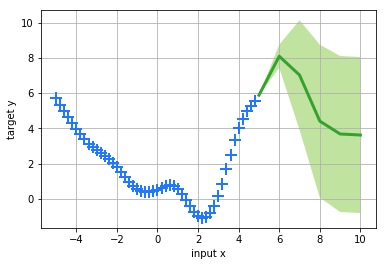Demo of pyGPs¶
Here, we demonstrate a short program to show how to use the pyGPs-package for regression tasks.
In [4]:
import numpy as np
import pyGPs
We are generating data by taking 50 evenly spaced values between -5 and 5 as our set of points X. For our respective set of points Y we are generating Gaussian-distributed values with a parabola shaped mean and an RBF Kernel with an added error term as our covariance:
In [5]:
X = np.arange(-5, 5, 0.2)
s = 1e-8 # error term
n = X.size
m = 1/4*np.square(X) # mean
a = np.repeat(X, n).reshape(n, n)
k = np.exp(-0.5*(a - a.transpose())**2) + s*np.identity(n) # covariance
Y = np.random.multivariate_normal(m, k, 1)
Y = Y.reshape(n) # Converting y from a
# matrix to an array
We treat the values \(x \in X\) (whilst \(X \subseteq \mathbb{R}\)) as our input points and the values \(y \in Y\) (\(Y \subseteq \mathbb{R}\)) as corresponding output points. Handing these over to our model variable as data, we can use pyGPs’ Gaussian Process Regression (With a zero mean, an RBF Kernel and Gaussian likelihood as default).
Note, that we’re using a zero mean Gaussian Process prior for our data, which has been generated by a parabola-shaped mean Gaussian. This shows the flexibility of the model.
Using this, we can predict output values for values of x outside of our initial range between -5 and 5.
In [17]:
model = pyGPs.GPR()
model.setData(X,Y)
# model.setPrior(mean=pyGPs.mean.Zero(), kernel=pyGPs.cov.RBF()) is redundant
model.optimize(X,Y)
model.predict(np.array([5,6,7,8,9,10]))
model.plot()
Number of line searches 40
